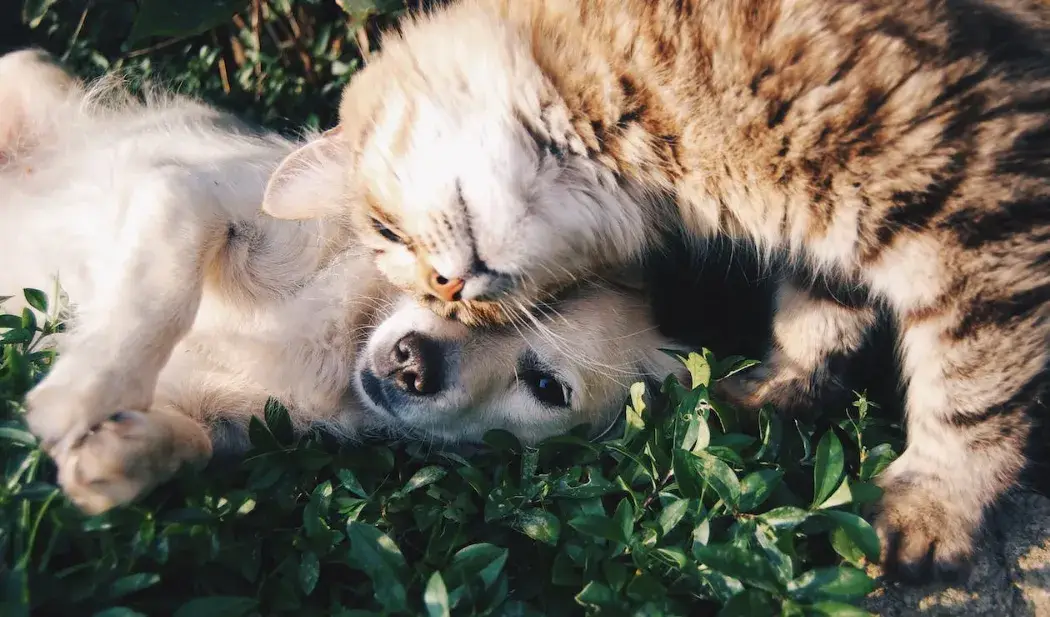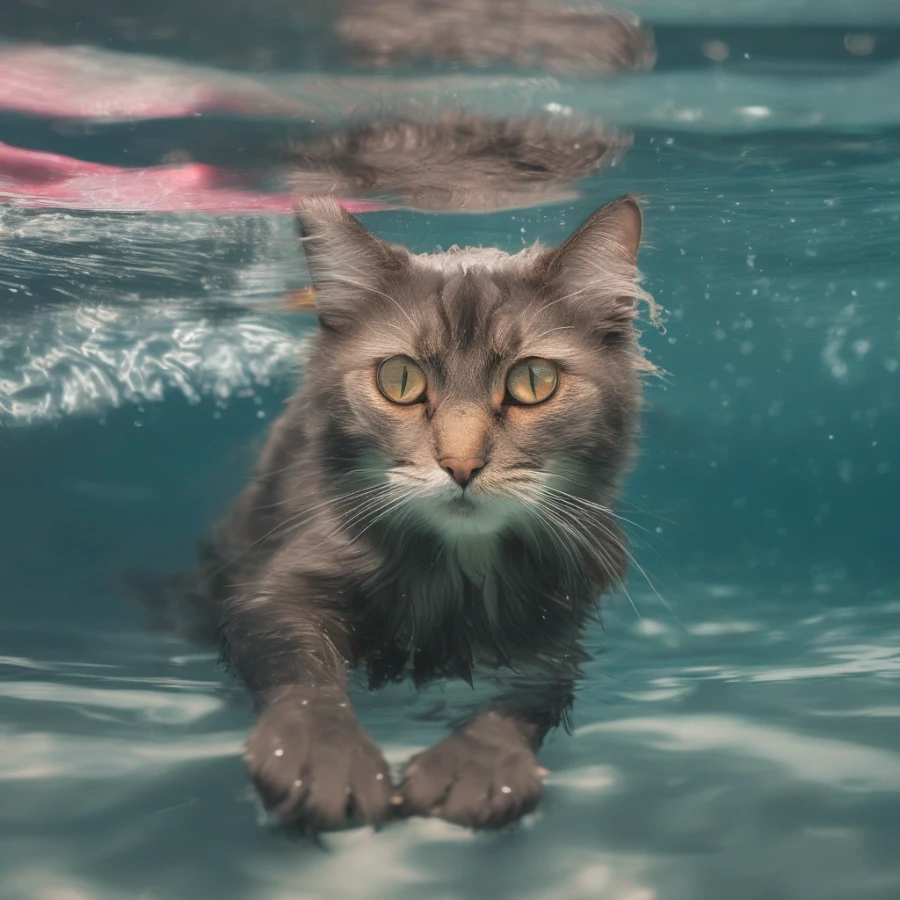My Cat Bullies My Dog

Published by: Tatsiana Korshik
Time to Read: 6 Min

If your cat is bullying your dog, it's important to address the behavior to ensure a harmonious and safe environment for both pets. Here are some steps you can take:
Supervision: Monitor interactions between your cat and dog closely. This will help you better understand the dynamics of their relationship and identify triggers for the bullying behavior.
Create Safe Spaces: Provide your cat with vertical spaces like shelves, cat trees, or perches where they can escape and observe without feeling threatened. This will give them a sense of security.
Separate Feeding Areas: Ensure that both pets have their own separate feeding areas. This prevents competition over food, which can lead to tension.
Positive Reinforcement: Reward your cat for calm and positive behavior around the dog. Use treats, toys, and praise to encourage desirable interactions.
Redirect Attention: Engage your cat in interactive play sessions to redirect their energy and aggression in a positive way.
Training: Train your dog to respond to commands such as "sit," "stay," and "leave it." This can help establish boundaries and prevent your dog from approaching the cat in a confrontational manner.
Gradual Introductions: If the bullying behavior started recently, consider reintroducing the pets using positive reinforcement techniques. Allow them to interact in controlled, positive situations.
Consult a Professional: If the bullying behavior is severe or persistent, consider consulting a professional animal behaviorist. They can provide tailored strategies for your specific situation.
Separate Time: Allow each pet some individual time and attention to prevent jealousy or competition.
Environmental Enrichment: Provide mental and physical stimulation for both pets. Puzzle feeders, toys, and interactive games can help prevent boredom and stress-related behaviors.
Consult a Veterinarian: If the bullying behavior is sudden or extreme, consult a veterinarian to rule out any medical issues that might be causing discomfort in either pet.
Training and Socialization: Enroll your dog in obedience classes or socialization sessions to improve their behavior around the cat.
Patience: Changing behavior takes time. Be patient and consistent with your efforts to modify the dynamics between your cat and dog.
Remember, every cat and dog has a unique personality, and it's essential to address their individual needs. Addressing bullying behavior early can help prevent stress, anxiety, and potential injuries. Your pets' well-being and safety should be your top priority, so don't hesitate to seek professional advice if needed.
Proper introductions are crucial. Gradually introduce them in a controlled environment, allowing them to become familiar with each other's scents and presence without direct contact. Use positive reinforcement and treats to associate each other with positive experiences.
It's important to understand and respect their individual personalities. Cats and dogs have different social structures and communication styles. Some cats are more social and adaptable, while others are more reserved. Similarly, dogs have different temperaments. Understanding and respecting these differences is key.
Using treats, toys, and praise to reward positive interactions and behavior can help both pets associate each other with positive experiences. This can create a foundation for a more positive relationship between them.
Providing both pets with their own safe spaces is essential. Cats often appreciate high spaces like shelves or cat trees, while dogs might benefit from crates or designated areas. Having these safe spaces helps them feel secure and reduces potential stress.
During the initial stages, monitor their interactions closely. Gradually increase their interaction time as their comfort level improves. This ensures their safety and allows you to intervene if any negative behaviors arise.
Enriching both pets' environments with toys, scratching posts, puzzle feeders, and other activities can keep them mentally stimulated and occupied. This can help reduce boredom and potentially alleviate any negative behaviors.
Developing a positive relationship takes time. Be patient and understand that progress might be slow. Both pets need to adjust to each other's presence, which can take weeks or even months.
If their interactions are consistently negative or aggressive, consider seeking the help of a professional animal behaviorist or trainer. They can provide guidance and create a customized plan for improving their relationship.
Consider their past experiences with other pets. If either pet has had negative experiences with cats or dogs before, it might impact their willingness to get along. Be mindful of their histories when working towards a positive relationship.
Establish a consistent routine for both pets. Predictable routines can help reduce stress and anxiety, making it easier for both of them to adapt to each other's presence.
While not all cats and dogs may become best friends, with time and effort, they can learn to tolerate and coexist peacefully. It's important to prioritize their safety and well-being and to be realistic about their interactions. Gradually working towards a positive relationship can lead to a more harmonious household for all.
Supervision: Monitor interactions between your cat and dog closely. This will help you better understand the dynamics of their relationship and identify triggers for the bullying behavior.
Create Safe Spaces: Provide your cat with vertical spaces like shelves, cat trees, or perches where they can escape and observe without feeling threatened. This will give them a sense of security.
Separate Feeding Areas: Ensure that both pets have their own separate feeding areas. This prevents competition over food, which can lead to tension.
Positive Reinforcement: Reward your cat for calm and positive behavior around the dog. Use treats, toys, and praise to encourage desirable interactions.
Redirect Attention: Engage your cat in interactive play sessions to redirect their energy and aggression in a positive way.
Training: Train your dog to respond to commands such as "sit," "stay," and "leave it." This can help establish boundaries and prevent your dog from approaching the cat in a confrontational manner.
Gradual Introductions: If the bullying behavior started recently, consider reintroducing the pets using positive reinforcement techniques. Allow them to interact in controlled, positive situations.
Consult a Professional: If the bullying behavior is severe or persistent, consider consulting a professional animal behaviorist. They can provide tailored strategies for your specific situation.
Separate Time: Allow each pet some individual time and attention to prevent jealousy or competition.
Environmental Enrichment: Provide mental and physical stimulation for both pets. Puzzle feeders, toys, and interactive games can help prevent boredom and stress-related behaviors.
Consult a Veterinarian: If the bullying behavior is sudden or extreme, consult a veterinarian to rule out any medical issues that might be causing discomfort in either pet.
Training and Socialization: Enroll your dog in obedience classes or socialization sessions to improve their behavior around the cat.
Patience: Changing behavior takes time. Be patient and consistent with your efforts to modify the dynamics between your cat and dog.
Remember, every cat and dog has a unique personality, and it's essential to address their individual needs. Addressing bullying behavior early can help prevent stress, anxiety, and potential injuries. Your pets' well-being and safety should be your top priority, so don't hesitate to seek professional advice if needed.
Will My Cat and Dog Ever Get Along
Whether your cat and dog will eventually get along depends on several factors, including their individual personalities, the way they are introduced, their previous experiences with each other, and your efforts as their owner. While some cats and dogs may become fast friends, others might need more time and guidance to develop a positive relationship.Proper introductions are crucial. Gradually introduce them in a controlled environment, allowing them to become familiar with each other's scents and presence without direct contact. Use positive reinforcement and treats to associate each other with positive experiences.
It's important to understand and respect their individual personalities. Cats and dogs have different social structures and communication styles. Some cats are more social and adaptable, while others are more reserved. Similarly, dogs have different temperaments. Understanding and respecting these differences is key.
Using treats, toys, and praise to reward positive interactions and behavior can help both pets associate each other with positive experiences. This can create a foundation for a more positive relationship between them.
Providing both pets with their own safe spaces is essential. Cats often appreciate high spaces like shelves or cat trees, while dogs might benefit from crates or designated areas. Having these safe spaces helps them feel secure and reduces potential stress.
During the initial stages, monitor their interactions closely. Gradually increase their interaction time as their comfort level improves. This ensures their safety and allows you to intervene if any negative behaviors arise.
Enriching both pets' environments with toys, scratching posts, puzzle feeders, and other activities can keep them mentally stimulated and occupied. This can help reduce boredom and potentially alleviate any negative behaviors.
Developing a positive relationship takes time. Be patient and understand that progress might be slow. Both pets need to adjust to each other's presence, which can take weeks or even months.
If their interactions are consistently negative or aggressive, consider seeking the help of a professional animal behaviorist or trainer. They can provide guidance and create a customized plan for improving their relationship.
Consider their past experiences with other pets. If either pet has had negative experiences with cats or dogs before, it might impact their willingness to get along. Be mindful of their histories when working towards a positive relationship.
Establish a consistent routine for both pets. Predictable routines can help reduce stress and anxiety, making it easier for both of them to adapt to each other's presence.
While not all cats and dogs may become best friends, with time and effort, they can learn to tolerate and coexist peacefully. It's important to prioritize their safety and well-being and to be realistic about their interactions. Gradually working towards a positive relationship can lead to a more harmonious household for all.



